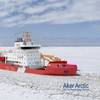New Great Lakes Icebreaker
Legislation authorizing construction of a new icebreaker for the Great Lakes is being applauded by the Great Lakes shipping community as key to the industry’s future. H.R. 1747, the Great Lakes Icebreaker Replacement Act of 2009, was introduced in the House of Representatives on March 26 by Rep. James L. Oberstar (D-MN).
“The Great Lakes are in desperate need of another modern icebreaker,” said Don Cree, President of Great Lakes Maritime Task Force (GLMTF) and President of the Toledo (Ohio) Port Council. “Most of the U.S. Coast Guard’s icebreaking assets are nearing the end of their productive lives. As a result, freighters have been experiencing significant delays and even suffering extensive damage. In the spring of 2008 alone, ice-related damages cost U.S.-Flag vessel operators $1.3m to repair.”
“The 10.4 million tons of iron ore that moved during the 2006/2007 ice season supported 100,000 jobs at iron ore mines and steel mills,” said James H.I. Weakley, 1st Vice President of GLMTF and President of Lake Carriers’ Association. “Those industries generate another 300,000 jobs in supplier industries. The employers who receive those cargos need to minimize stockpiling costs to remain competitive. That’s why since 1936 an Executive Order has directed the U.S. Coast Guard to break ice on the nation’s waterways. The men and women of the Ninth Coast Guard District are as dedicated a public servant as any you will find, but the simple fact is most of the icebreaking assets are inadequate to meet the needs of commerce.”
The U.S. Coast Guard has eight icebreaking assets stationed on the Great Lakes. The newest is the Mackinaw, which was launched in 2006. This vessel has proven extremely capable in all ice conditions. Two vessels were built earlier this decade, but they were not designed specifically for icebreaking and have experienced difficulty in heavy ice conditions.
The other five vessels were built in the late 1970s. They are now prone to breakdowns and replacement parts are becoming increasingly difficult to procure.
“We have a proven design in the Mackinaw,” said John D. Baker, 2nd Vice President of GLMTF and President Emeritus of the ILA’s Great Lakes District Council. “H.R. 1747 wisely calls for a sister ship to be built.”
Baker also noted that having another modern icebreaker is important to the overseas trade to the Great Lakes via the St. Lawrence Seaway. “Vessel operators will not come to the Lakes when the Seaway opens if they fear being delayed or damaged by heavy ice. They will wait ‘til the ice clears. The same will be true at the end of the season. They will cancel their final voyages rather than risk being trapped on the Lakes over the winter.”
“The ice that forms on the Lakes is formidable,” said Patrick J. O’Hern, 3rd Vice President of GLMTF and Vice President and General Manager of Bay Shipbuilding Company. “After the harsh winter of 1993/1994, the Coast Guard was breaking ice in the St. Marys River until mid-May.”











